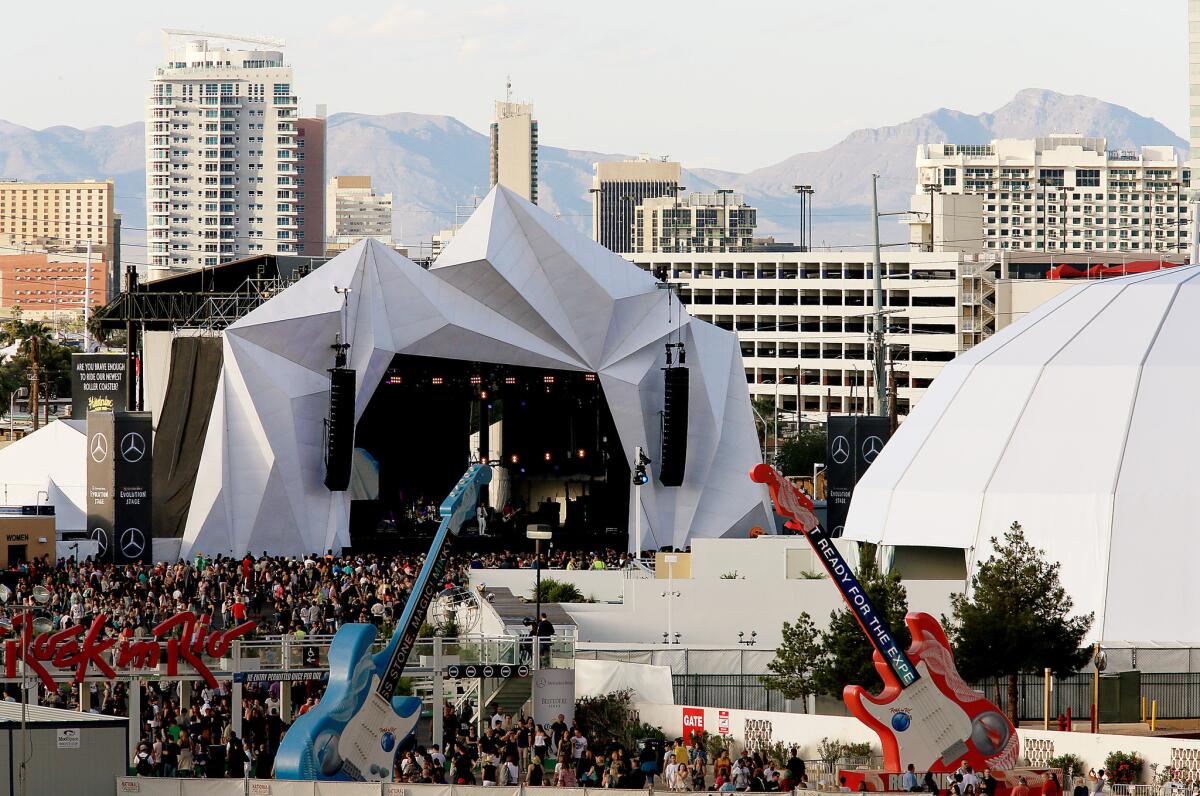Rock in Rio report card: 6 ways to make a better festival

Music fans stream into the City of Rock for the last day of
- Share via
For more than a year, organizers promised that the inaugural U.S. edition of the Brazilian-born Rock in Rio would be unlike anything the American public had seen.
Equal parts concert, amusement park and street party, the two-weekend festival looked to reinvigorate a forgotten swath of the Las Vegas Strip and also compete amid the landscape of well-oiled music festivals that have managed to turn places like the sprawling polo grounds of the Coachella Valley or a muddy farm in Manchester, Tenn., into essential getaways for music fans.
With cleanup after the festival’s closing on Sunday still underway, it’s a good time to look back and see whether this first Rock in Rio USA delivered on those grand ambitions.
Situated on 40 acres that once served as the recreational vehicle campground for Circus Circus, the $25-million custom-made City of Rock boasted six stages of music, a 600-foot zip line that sent festival-goers flying over the main stage, a giant Ferris wheel and three themed miniature “rock streets” inspired by U.S., Britain and Brazil.
There were fireworks and Brazilian capoeira drummers, acrobats on stilts and Irish cloggers, tap dancers and daiquiris and an EDM stage in the shape of a spider.
But even before it began, Rock in Rio USA felt like a gamble.
Although the decades-old international festival boasted a staggering track record before coming here — 7 million tickets sold since 1985 at festivals in Brazil, Portugal and Spain; $23 million contributed to social and environmental causes; substantial economic boosts to the cities — the festival had little profile in America. Setting up in a city with 24/7 entertainment options and a market packed with established music festivals such as Lollapalooza, Bonnaroo and the Coachella Valley Music and Arts Festival, the odds were stacked against Rock in Rio.
Still, over the course of four days and nearly 50 hours of music, Rock in Rio attracted 172,000 attendees, who came to see Metallica, No Doubt, Mana, Linkin Park, Taylor Swift, Ed Sheeran, John Legend, Jessie J, Big Sean, Bruno Mars and many more. Its debut can easily be considered a success. But there is room for major improvement.
With plans for the stateside edition to be presented biannually (2017 and 2019 are already guaranteed), organizers should use the time to iron out the frustrating quirks and flesh out the concepts that could make Rock in Rio a worthy entry in festival season.
Having attended both weekends, I kept a running tab of what needs tweaking and have these suggestions for changes the organizers should consider making before Rock in Rio USA’s return.
Let rock and pop co-exist. Rock in Rio splits its lineup between rock and pop, with acts sorted accordingly. Consider doing away with the genre-specific bills and instead curate a more focused lineup that hop-skips across genres. There were pockets during the rock weekend that felt thin (both in terms of talent and crowd energy) in comparison to the tightly packed first day of pop offerings.
Chances are the ticket buyer who wants to see No Doubt also enjoys Bruno Mars. Hip-hop was nonexistent beyond Big Sean, a massive wasted opportunity given rap’s ubiquitous presence on radio. And the pop weekend seemed to have a number of overlapping ideas. Blockbuster headliners are fine, but they play everywhere — particularly on the West Coast. Next time, aim for a stronger narrative when it comes to major artists. Even better, dig deeper into the fringe. It will allow for better discovery and make for a more intriguing lineup.
Rethink EDM. The curated lineup of electronic acts — EDM, bass and trap music; female DJs from L.A.; and global house — were a noble effort. But reconsider this. The Strip is rife with superstar DJ residencies, and the twentysomethings that pack the litany of clubs on any given night in Vegas are well aware of this. It is nearly impossible for the festival to compete with the marquee acts offered minutes away, unless the highest caliber of acts are being booked — and that’s unlikely due to Electric Daisy Carnival. Ditch the EDM lineup.
Also, the 360-degree dance stage was a fantastic concept, but it wasn’t utilized properly since the crowd rarely packed it. Use this as a platform to create a different experience by booking acts that would be playing a small club - an emerging rapper or indie band or guitarist for example.
Check the calendar. There is always something going on in Vegas, making entertainment options as endless as the desert day is long. Just look at all that happened around Rock in Rio. It debuted a week after the Floyd Mayweather and Manny Pacquiao fight, and the same week as Mariah Carey’s opening night of her new residency. During weekend two was a show from Carey and Britney Spears (all in one night) plus the Billboard Music Awards. Those are great anchors for visitors, but imagine the uptick in ticket sales had organizers waited a week and done Memorial Day weekend when even more out-of-towners flock to the Strip.
Consider one long weekend. Organizers should consider building a three-day weekend instead of the back-to-back two-day offerings over two weeks. More people would likely be interested in a three-day experience than picking one lineup.
Curate the themed rock streets better. At times Rock in Rio USA felt like a wild party and at times it drowned in Vegas absurdity. While it’s unlikely that any other festival offers a neon-lit wedding chapel, juggling leprechauns and a conga line alongside music offerings, the themed rock streets could use a major overhaul. After all, they are a massive part of what makes this experience different, and some of festival’s cooler moments happened there.
For starters, curate the side stages better. Bring in more small acts — singers, guitar strummers, street artists — to share slots with the dancers and performers. Go all out on the side shows; this is Vegas after all. Imagine if the streets were lined with fire-breathers or sword swallowers or magicians or showgirls.
And the “themed streets” need some serious work. If it wasn’t for the acts on the respective stages, people would have no idea where they were supposed to be. The facades all felt and looked similar. Make the strips more authentic, with signs and vendors catered specifically to each district. How can it be Rock Street UK without a place to get fish and chips and a pint?
Drop the cashless wristband. Logistics were the biggest challenge on site, something even a well-organized festival such as Coachella encounters. Rock in Rio ironed out most of those kinks on its first weekend. But despite its second and final weekend running smoothly, the one thing that left a sour taste for many was the festival’s no-cash, no-credit-card policy. Having wristbands serve as currency (funds were loaded via on-site stations or online) was touted as a way to make lines a breeze, but ultimately the experience was a headache.
Refunds carried a $3.50 processing fee, and with tax pegged onto pretty much everything you purchased, keeping an even balance was impossible. Just think, if each ticketed guest requested a refund, the service would generate more than $600,000, according to our math — which makes it appear that the system benefited everyone but the festival-goer. Tapping a wristband at the stand was convenient, but it didn’t make things quicker (especially in the liquor lines) — not when you factor in the shop attendant asking if you wanted to tip with a second tap to complete the order. Lines would have flowed just the same if there was a credit-card swipe. Coachella started taking credit cards this year, and when ranking the booze-and-food buying experience at both, Coachella was quicker.
For more music news follow me on Twitter: @gerrickkennedy
More to Read
The biggest entertainment stories
Get our big stories about Hollywood, film, television, music, arts, culture and more right in your inbox as soon as they publish.
You may occasionally receive promotional content from the Los Angeles Times.










